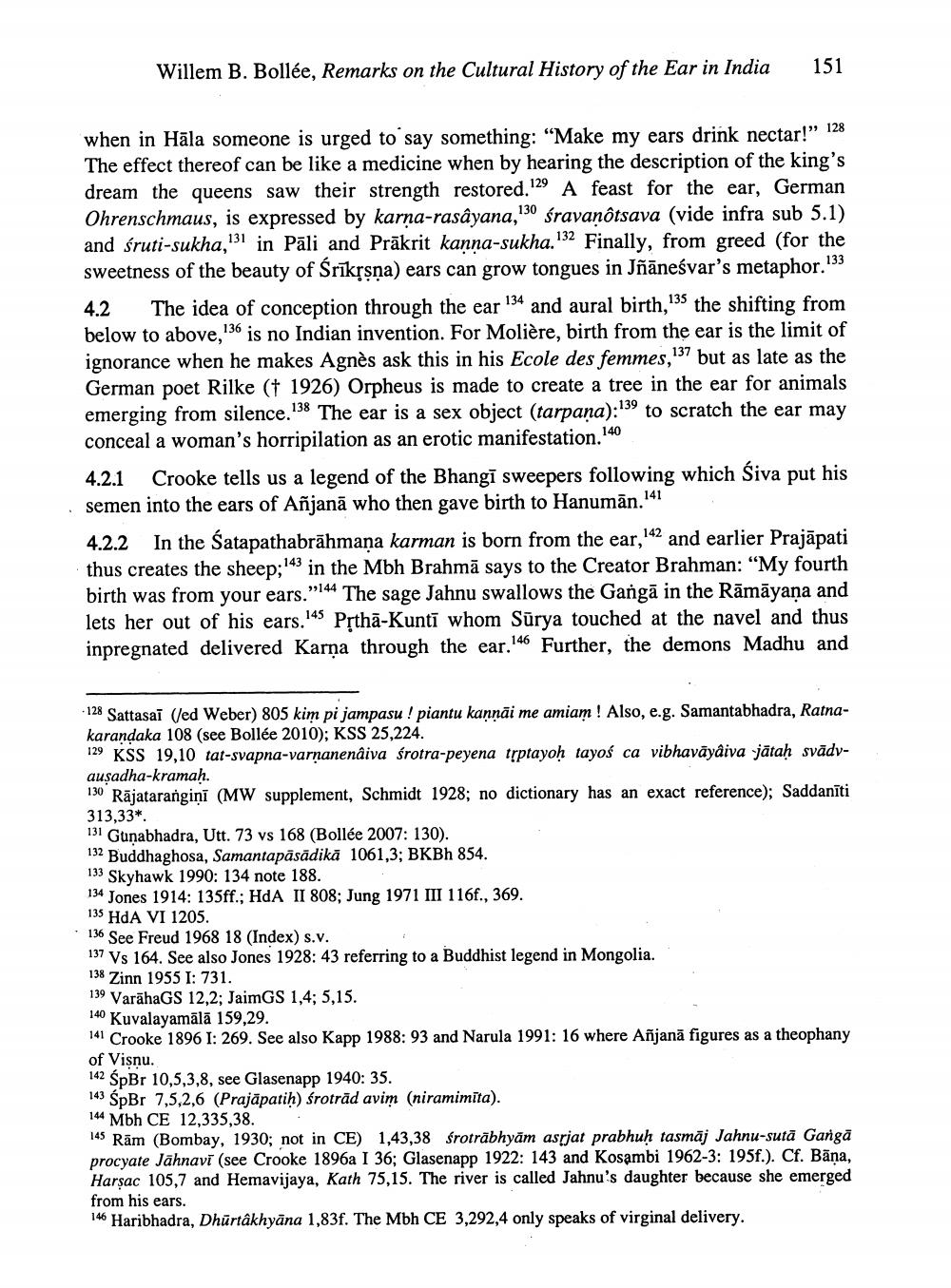________________
Willem B. Bollée, Remarks on the Cultural History of the Ear in India
when in Häla someone is urged to say something: "Make my ears drink nectar!" 128 The effect thereof can be like a medicine when by hearing the description of the king's dream the queens saw their strength restored.129 A feast for the ear, German Ohrenschmaus, is expressed by karna-rasâyana,130 śravanôtsava (vide infra sub 5.1) and śruti-sukha,131 in Pali and Prakrit kanna-sukha. 132 Finally, from greed (for the sweetness of the beauty of Śrīkṛṣṇa) ears can grow tongues in Jñäneśvar's metaphor.133
135
4.2 The idea of conception through the ear 14 and aural birth," the shifting from below to above, 136 is no Indian invention. For Molière, birth from the ear is the limit of ignorance when he makes Agnès ask this in his Ecole des femmes,137 but as late as the German poet Rilke († 1926) Orpheus is made to create a tree in the ear for animals emerging from silence.138 The ear is a sex object (tarpana):139 to scratch the ear may conceal a woman's horripilation as an erotic manifestation."
151
4.2.1
his
Crooke tells us a legend of the Bhangi sweepers following which Śiva put semen into the ears of Añjana who then gave birth to Hanuman.141
4.2.2 In the Satapathabrāhmaṇa karman is born from the ear, 142 and earlier Prajapati thus creates the sheep;143 in the Mbh Brahmä says to the Creator Brahman: "My fourth birth was from your ears.' 44 The sage Jahnu swallows the Ganga in the Rāmāyaṇa and lets her out of his ears. Prthä-Kunti whom Sürya touched at the navel and thus inpregnated delivered Karna through the ear. Further, the demons Madhu and
145
-128 Sattasai (/ed Weber) 805 kim pi jampasu! piantu kannai me amiam! Also, e.g. Samantabhadra, Ratnakarandaka 108 (see Bollée 2010); KSS 25,224.
12 KSS 19,10 tat-svapna-varnanendiva frotra-peyena trptayoh tayoś ca vibhavaydiva jätaḥ svädvausadha-kramaḥ.
130 Rājatarangini (MW supplement, Schmidt 1928; no dictionary has an exact reference); Saddanīti 313,33*.
131 Gunabhadra, Utt. 73 vs 168 (Bollée 2007: 130).
132 Buddhaghosa, Samantapāsādikā 1061,3; BKBh 854.
133 Skyhawk 1990: 134 note 188.
134 Jones 1914: 135ff.; HdA II 808; Jung 1971 III 116f., 369.
135 HdA VI 1205.
136 See Freud 1968 18 (Index) s.v.
137 Vs 164. See also Jones 1928: 43 referring to a Buddhist legend in Mongolia.
138 Zinn 1955 I: 731.
139 VarahaGS 12,2; JaimGS 1,4; 5,15.
100 Kuvalayamälä 159,29.
141 Crooke 1896 I: 269. See also Kapp 1988: 93 and Narula 1991: 16 where Añjana figures as a theophany
of Visnu.
142 SpBr 10,5,3,8, see Glasenapp 1940: 35.
SpBr 7,5,2,6 (Prajapatiḥ) śroträd avim (niramimita).
144 Mbh CE 12,335,38.
145 Rām (Bombay, 1930; not in CE) 1,43,38 frotrābhyam asrjat prabhuḥ tasmāj Jahnu-sutā Gangā procyate Jahnavi (see Crooke 1896a I 36; Glasenapp 1922: 143 and Kosambi 1962-3: 195f.). Cf. Bāṇa, Harṣac 105,7 and Hemavijaya, Kath 75,15. The river is called Jahnu's daughter because she emerged from his ears.
146 Haribhadra, Dhūrtâkhyāna 1,83f. The Mbh CE 3,292,4 only speaks of virginal delivery.




